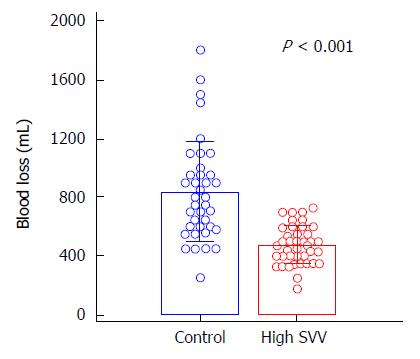Copyright
©The Author(s) 2015.
World J Gastroenterol. Dec 7, 2015; 21(45): 12757-12766
Published online Dec 7, 2015. doi: 10.3748/wjg.v21.i45.12757
Published online Dec 7, 2015. doi: 10.3748/wjg.v21.i45.12757
Figure 1 Evolution of liver transplantation at Asan Medical Center, University of Ulsan College of Medicine.
From February 1997 to April 2013, 3000 ALDLTs were performed without donor mortality. As of 2010, the annual number of ALDLTs exceeded 300 and with increased performance of ABO-incompatible ALDLT. ALDLT: Adult living donor liver transplantation; DDLT: Deceased donor liver transplantation; LDLT: Living donor liver transplantation; RL: Right-lobe; LL: Left-lobe; LT: Liver transplantation; OLT: Orthotopic liver transplantation. Jan: January; Feb: February; Mar: March; Apr: April; Jul: July; Aug: August; Sep: September; Oct: October; Nov: November; Dec: December. Reprinted with permission[4].
Figure 2 Effect of stroke volume variation-directed fluid management on blood loss during living donor right hepatectomy.
The control group (< 10% SVV) received usual fluid management (6-10 mL/kg per hour during surgery), whereas the high SVV group underwent fluid restriction (2-4 mL/kg per hour until completion of hepatectomy) with SVV ranging from 10% to 20%. Blood loss was significantly lower in the high SVV than in the control group. SVV: Stroke volume variation. Reproduced data with permission[15].
Figure 3 Proposed algorithm of stroke volume variation-guided fluid management during living donor hepatectomy.
SVV: Stroke volume variation. Modified with permission[15].
- Citation: Choi SS, Kim SH, Kim YK. Fluid management in living donor hepatectomy: Recent issues and perspectives. World J Gastroenterol 2015; 21(45): 12757-12766
- URL: https://www.wjgnet.com/1007-9327/full/v21/i45/12757.htm
- DOI: https://dx.doi.org/10.3748/wjg.v21.i45.12757











